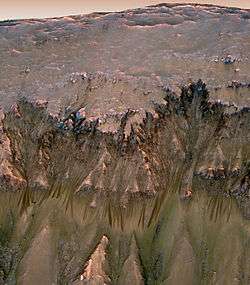Newton (Martian crater)
|
Gullies inside a small crater within Newton Crater | |
| Planet | Mars |
|---|---|
| Coordinates | 40°48′S 201°54′E / 40.8°S 201.9°ECoordinates: 40°48′S 201°54′E / 40.8°S 201.9°E |
| Diameter | 298 km |
| Eponym | Sir Isaac Newton |
Newton is a large crater on Mars, with a diameter close to 300 km.[1] It is located south of the planet's equator in the heavily cratered highlands of Terra Sirenum in the Phaethontis quadrangle. The impact that formed Newton likely occurred more than 3 billion years ago. The crater contains smaller craters within its basin and is particularly notable for gully formations that are presumed to be indicative of past liquid water flows. Many small channels exist in this area; they are further evidence of liquid water. On the basis of their form, aspects, positions, and location amongst and apparent interaction with features thought to be rich in water ice, many researchers believed that the processes carving the gullies involve liquid water. However, this remains a topic of active research. As soon as gullies were discovered,[2] researchers began to image many gullies over and over, looking for possible changes. By 2006, some changes were found.[3] Later, with further analysis it was determined that the changes could have occurred by dry granular flows rather than being driven by flowing water.[4][5][6] With continued observations many more changes were found in Gasa Crater and others.[7] With more repeated observations, more and more changes have been found; since the changes occur in the winter and spring, experts are tending to believe that gullies were formed from dry ice. Before-and-after images demonstrated the timing of this activity coincided with seasonal carbon-dioxide frost and temperatures that would not have allowed for liquid water. When dry ice frost changes to a gas, it may lubricate dry material to flow especially on steep slopes.[8][9][10] In some years frost, perhaps as thick as 1 meter.
The crater was named in 1973 by the International Astronomical Union (IAU) Working Group for Planetary System Nomenclature (WGPSN) in honor of Sir Isaac Newton.

In 2011 it was announced that images captured by NASA's Mars Reconnaissance Orbiter have suggested the presence of possible flowing water during the warmest months on Mars, as shown in images taken of Newton Crater and Horowitz Crater among others.
 Gullies in crater on rim of Newton Crater, as seen by HiRISE, under HiWish program.
Gullies in crater on rim of Newton Crater, as seen by HiRISE, under HiWish program.- Channels on the floor of Newton Crater, as seen by THEMIS. Click on image to see relationship of Newton to other nearby craters.
 Channel on floor of Newton Crater, as seen by HiRISE under HiWish program.
Channel on floor of Newton Crater, as seen by HiRISE under HiWish program. Gullies near Newton Crater, as seen by HiRISE under the HiWish Program.
Gullies near Newton Crater, as seen by HiRISE under the HiWish Program.
Dunes
 Dunes in Newton Crater, as seen by HiRISE under HiWish program
Dunes in Newton Crater, as seen by HiRISE under HiWish program Close view of dunes in Newton Crater, as seen by HiRISE under HiWish program
Close view of dunes in Newton Crater, as seen by HiRISE under HiWish program Close view of dunes in Newton Crater, as seen by HiRISE under HiWish program
Close view of dunes in Newton Crater, as seen by HiRISE under HiWish program Close view of dunes in Newton Crater showing ripples on surface, as seen by HiRISE under HiWish program
Close view of dunes in Newton Crater showing ripples on surface, as seen by HiRISE under HiWish program
See also
- Planetary nomenclature
- Impact crater
- List of craters on Mars
- Water on Mars
- Climate of Mars
- Martian Gullies
References
- ↑ http://www.google.com/mars/
- ↑ Malin, M., Edgett, K. 2000. Evidence for recent groundwater seepage and surface runoff on Mars. Science 288, 2330–2335.
- ↑ Malin, M., K. Edgett, L. Posiolova, S. McColley, E. Dobrea. 2006. Present-day impact cratering rate and contemporary gully activity on Mars. Science 314, 1573_1577.
- ↑ Kolb, et al. 2010. Investigating gully flow emplacement mechanisms using apex slopes. Icarus 2008, 132-142.
- ↑ McEwen, A. et al. 2007. A closer look at water-related geological activity on Mars. Science 317, 1706-1708.
- ↑ Pelletier, J., et al. 2008. Recent bright gully deposits on Mars wet or dry flow? Geology 36, 211-214.
- ↑ NASA/Jet Propulsion Laboratory. "NASA orbiter finds new gully channel on Mars." ScienceDaily. ScienceDaily, 22 March 2014. www.sciencedaily.com/releases/2014/03/140322094409.htm
- ↑ http://www.jpl.nasa.gov/news/news.php?release=2014-226
- ↑ http://hirise.lpl.arizona.edu/ESP_032078_1420
- ↑ http://www.space.com/26534-mars-gullies-dry-ice.html?cmpid=557882
External links
| Wikimedia Commons has media related to Newton (Martian crater). |
- Google Mars linked to the Newton Crater
- NASA Astronomy Picture of the Day: Newton Crater: Evidence for Recent Water on Mars (26 June 2000)
- Newton Crater
- Solar Views
